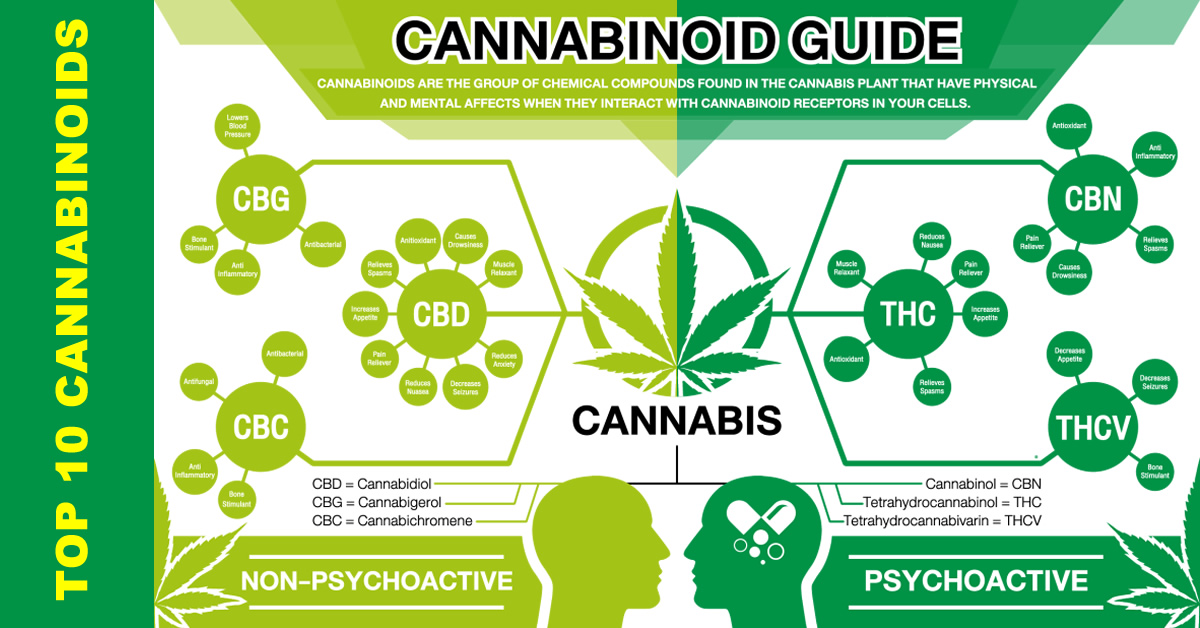The Complete Guide to the Top 10 Cannabinoids: What Every Consumer Should Know

Cannabis contains over 100 different cannabinoids, but only a select few have captured the attention of researchers, medical professionals, and consumers worldwide. Understanding
these powerful compounds can help you make informed decisions when exploring cannabis
products for wellness, recreation, or therapeutic purposes.
What Are Cannabinoids?
Cannabinoids are naturally occurring chemical compounds found in cannabis plants that interact with your body’s endocannabinoid system. This complex network of receptors influences everything from mood and appetite to pain perception and sleep cycles. While THC and CBD dominate headlines, numerous other cannabinoids offer unique benefits and effects.
The Top 10 Most Important Cannabinoids
1. THC (Delta-9-Tetrahydrocannabinol)
Primary Effects: Psychoactive euphoria, pain relief, appetite stimulation
THC remains the most well-known cannabinoid, responsible for cannabis’s signature psychoactive effects. Beyond recreational use, THC demonstrates significant therapeutic potential for chronic pain, nausea, muscle spasticity, and appetite loss. Medical patients often seek THC-dominant strains for conditions like cancer treatment side effects and glaucoma.
Typical Concentration: 15-30% in modern cannabis strains
2. CBD (Cannabidiol)
Primary Effects: Non-psychoactive relaxation, anti-inflammatory, anxiety reduction
CBD has revolutionized cannabis perception by offering therapeutic benefits without intoxication. Research supports its effectiveness for epilepsy, anxiety disorders, inflammation, and sleep disturbances. The FDA has approved Epidiolex, a CBD-based medication for specific seizure disorders, highlighting its medical legitimacy.
Typical Concentration: 0.1-20% depending on strain selection
3. CBG (Cannabigerol)
Primary Effects: Mild energy boost, antibacterial properties, potential neuroprotection
Often called the “mother cannabinoid,” CBG serves as the precursor to other cannabinoids during plant development. Early research suggests CBG may combat bacterial infections, reduce intraocular pressure, and support digestive health. Its subtle energizing effects make it popular for daytime consumption.
Typical Concentration: 0.1-2% in most strains
4. CBN (Cannabinol)
Primary Effects: Sedation, sleep promotion, mild psychoactivity
CBN forms when THC degrades through oxidation and aging. This breakdown product exhibits potent sedative qualities, earning recognition as nature’s sleeping aid. Many consumers prefer CBN-rich products for insomnia, restlessness, and nighttime anxiety management.
Typical Concentration: 0.1-1% in aged cannabis
5. CBC (Cannabichromene)
Primary Effects: Anti-inflammatory, mood enhancement, potential neurogenesis
CBC works synergistically with other cannabinoids to amplify therapeutic effects through the entourage effect. Research indicates CBC may stimulate brain cell growth, reduce inflammation, and combat depression. Its non-psychoactive nature makes it suitable for daily wellness routines.
Typical Concentration: 0.1-1% in most varieties
6. Delta-8 THC
Primary Effects: Mild psychoactivity, reduced anxiety, appetite stimulation
Delta-8 THC offers a gentler alternative to traditional Delta-9 THC, producing clear-headed euphoria with less anxiety and paranoia. This cannabinoid has gained popularity among consumers seeking THC benefits without overwhelming psychoactive intensity. Legal status varies by jurisdiction.
Typical Concentration: Naturally occurs in trace amounts, often concentrated through extraction
7. THCV (Tetrahydrocannabivarin)
Primary Effects: Appetite suppression, energy enhancement, potential diabetes management
THCV presents unique properties that contrast sharply with THC’s appetite-stimulating effects. Research suggests THCV may help regulate blood sugar, reduce panic attacks, and promote weight management. Its energizing qualities make it valuable for focus and productivity.
Typical Concentration: 0.1-2% in specific African sativa strains
8. CBDV (Cannabidivarin)
Primary Effects: Anticonvulsant, nausea reduction, potential autism spectrum support
CBDV shares structural similarities with CBD but offers distinct therapeutic applications. Clinical trials explore its effectiveness for epilepsy, particularly Rett syndrome and autism spectrum disorders. Its antiemetic properties also show promise for nausea management.
Typical Concentration: 0.1-1% in certain strains
9. THCA (Tetrahydrocannabinolic Acid)
Primary Effects: Anti-inflammatory, neuroprotective, non-psychoactive (until heated)
THCA represents THC’s raw, acidic form before decarboxylation through heat or time. In its natural state, THCA provides anti-inflammatory and neuroprotective benefits without psychoactivity. Many wellness enthusiasts consume raw cannabis or THCA tinctures for therapeutic effects.
Typical Concentration: 15-25% in fresh, unprocessed cannabis
10. CBDA (Cannabidiolic Acid)
Primary Effects: Anti-nausea, anti-inflammatory, potential COVID-19 inhibition
CBDA serves as CBD’s precursor and demonstrates impressive therapeutic potential in its raw form. Recent studies suggest CBDA may prevent certain viral infections and reduce nausea more effectively than CBD itself. Raw consumption preserves these beneficial acidic cannabinoids.
Typical Concentration: 10-20% in fresh, high-CBD strains
Understanding the Entourage Effect
These cannabinoids rarely work in isolation. The entourage effect describes how cannabinoids, terpenes, and other cannabis compounds interact synergistically to enhance therapeutic benefits. Full-spectrum products preserve these natural relationships, often providing superior effects compared to isolated compounds.
Choosing the Right Cannabinoid Profile
Your ideal cannabinoid combination depends on personal goals, tolerance levels, and desired effects:
For Relaxation: High CBD products with minor CBN and CBC For Energy: CBG and THCV dominant profiles For Sleep: CBN-rich formulations with moderate THC For Pain: Balanced
THC/CBD ratios with CBC For Focus: Low-dose THC with CBG and THCV
Legal Considerations and Safety
Cannabinoid legality varies significantly by location and compound. While hemp-derived CBD enjoys federal legality in the United States, other cannabinoids exist in regulatory grey areas. Always research local cannabis laws and consult healthcare providers before incorporating cannabinoids into wellness routines.
The Future of Cannabinoid Research
Scientific understanding of cannabinoids continues expanding rapidly. Researchers are discovering new compounds and therapeutic applications regularly, promising exciting developments in personalized cannabis medicine and targeted wellness solutions.
Finding Quality Cannabinoid Products
When selecting cannabinoid products, prioritize:
- Third-party laboratory testing for potency and purity
- Clear labeling with specific cannabinoid concentrations
- Reputable manufacturers with transparent production methods
- Proper storage and handling to preserve cannabinoid integrity
Understanding these ten essential cannabinoids empowers informed decision-making in the evolving cannabis landscape. Whether seeking therapeutic relief or wellness enhancement, knowledge of cannabinoid profiles helps optimize your cannabis experience while maximizing potential benefits.
Always consult qualified healthcare professionals before using cannabis products for medical purposes. This information is for educational purposes and does not constitute medical advice.
-

Retro Highz x Empire Glassworks Retro Sneaker V2 Glass Hand Pipe | 4″
-

Fumed Galaxy Spoon
Price range: $34.99 through $39.99 -

Warrior Piper IInside-Out Funnel Chillum Herb Pipe
$36.99 -

Alien Head Hand Pipe – 5″ / 25CT
$139.90 -

Mind Melter Mini Bubbler – 4.25″/ 20ct
$271.60 -

Crush Fang Bub Pipe w/Dual Galaxy Marbles (Various Colors)
$59.99



